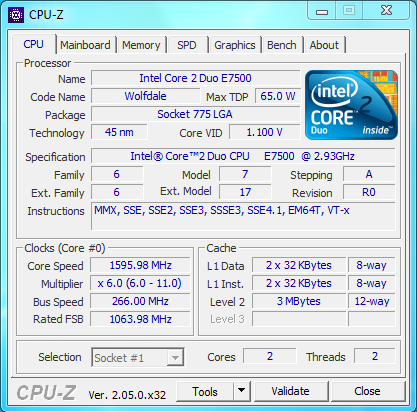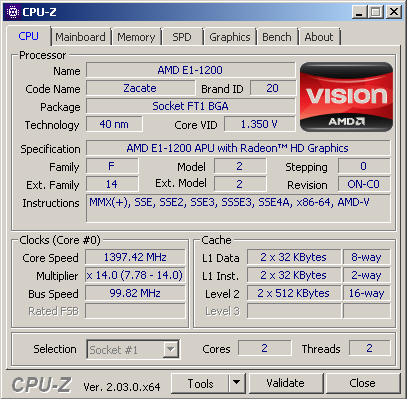Comparing: AMD E1-1200 vs Intel Core 2 Duo E7500
In this comparison, we analyze two Processors: AMD E1-1200 and Intel Core 2 Duo E7500, using synthetic benchmark tests to evaluate their overall performance. This side-by-side comparison helps users understand which hardware delivers better value, speed, and efficiency based on standardized testing. Whether you're building a new system or upgrading an existing one, this benchmark-driven evaluation offers valuable insights to guide your decision.

Intel Core 2 Duo E7500
| Type: | Processors |
|---|---|
| Brand: | Intel |
| Model: | Core 2 Duo E7500 |
Specification Comparison Table
This specification comparison presents technical details of several devices or components to help you understand the key differences between each option. Use this table as a reference to determine which device best suits your needs.
| Specification | AMD E1-1200 | Intel Core 2 Duo E7500 |
|---|---|---|
| Architecture | x86 | x86 |
| Technology | 40 nm | 45 nm |
| Clock | 1.4 GHz - - | 2.93 GHz - - |
| Core/Thread | 2 / 2 | 2 / 2 |
| Segmen | Mobile | Desktop |
Submission Comparison Table
This submission comparison table displays the number and details of benchmark data submissions from various devices or components. This information helps you understand the performance based on the benchmarks that have been tested, as well as providing an overview of the consistency and popularity of the available benchmark results.
| No. | Benchmark Software | AMD E1-1200 | Intel Core 2 Duo E7500 |
|---|---|---|---|
| 1 | Cinebench - 2003 |
292 cb |
986 cb |
| 2 | Cinebench - R11.5 |
0.54 pts |
1.61 pts |
| 3 | CPU-Z Benchmark - Multi Thread |
108.4 points |
225.2 points |
| 4 | CPU-Z Benchmark - Single Thread |
57.7 points |
113.2 points |
| 5 | Geekbench3 - Multi Core |
1050 points |
2862 points |
| 6 | Geekbench3 - Single Core |
575 points |
1558 points |
| 7 | PiFast |
1min, 49sec, 900ms |
34sec, 90ms |
| 8 | SuperPi - 1M |
55sec, 754ms |
18sec, 470ms |
| 9 | wPrime - 32M |
1min, 8sec, 78ms |
27sec, 191ms |
Submission Comparison Chart
This chart visualizes the benchmark scores comparison between two hardware devices based on submitted data.
Media Gallery
A collection of photos of tested hardware. These images can help you identify the physical form, model, and variant of the hardware in question. These photos are from our own documentation, and if they are not available we may not be able to document them.
About Hardware AMD E1-1200
Released in 2012 as part of the Brazos 2.0 family, the AMD E1-1200 is a power-efficient processor aimed at entry-level laptops. It has a 2 core and 2 thread configuration with a fixed clock speed of 1.4 GHz, with no support for Turbo Core technology. Built with a 40nm fabrication process, the E1-1200 has a TDP value of 18 watts-efficient enough for portable devices that emphasize low power consumption and longer battery life. Despite its limited performance, the E1-1200 was a popular choice in its day thanks to its affordable price and ability to handle light computing needs.
One of the main advantages of the AMD E1-1200 is the integrated Radeon HD 7310 GPU, which offers better graphics performance than Intel's entry-level graphics solutions at the time. This GPU has the ability to play HD resolution videos smoothly, as well as run light games such as Counter Strike 1.6, Plants vs Zombies, or other casual games with minimum graphics settings. That said, this combination of CPU and GPU is not intended for heavy-duty work such as video editing, 3D rendering, or modern gaming. Overall performance is more optimal when used for tasks such as browsing, streaming videos, accessing social media, typing documents, as well as basic office applications.
However, it should be noted that the AMD E1-1200 is less suitable for heavy multitasking, especially in modern operating systems like Windows 10. With a low clock speed and no Boost feature, users may experience lag or limitations when opening multiple applications at once. In tests using the HP 1000 1b05au laptop, this processor was paired with 4GB DDR3 single channel RAM (2 DIMM slots) and tested on Windows 7, Windows 8, and Windows 10 operating systems. The results show that the most optimal performance is achieved on Windows 7 or Windows 8, while in Windows 10 the system tends to be slow although it can still be used for basic needs. As such, the AMD E1-1200 can still be relied upon as a power-efficient and inexpensive solution for users with very light computing needs.
Hardware Detail:
Device: HP 1000 1b05au
RAM: 4GB DDR3 Single Channel 2 DIMM
OS: Windows 7, Windows 8, Windows 10
Wednesday, 26 December 2012 14:27:36 | Update: 1 month ago
About Hardware Intel Core 2 Duo E7500
The Intel Core 2 Duo E7500 is a desktop processor released in 2009, based on the Wolfdale architecture, which is part of Intel’s Core 2 Duo family. It features 2 cores and 2 threads, running at a clock speed of 2.93 GHz, and operates with a 1066 MHz Front Side Bus (FSB).
Manufactured using 45nm process technology, the E7500 has a TDP of 65W, which was considered energy-efficient for its time. However, this processor does not support Hyper-Threading or Turbo Boost, meaning its performance is limited to strictly single-threaded and basic dual-threaded applications.
In terms of modern computing standards, the Core 2 Duo E7500 is outdated and performs well below current entry-level processors. Despite this, it can still be useful in legacy systems for light workloads such as basic web browsing, office documents, and 480p–720p video playback, especially when paired with a lightweight operating system.
Thursday, 09 March 2023 02:31:57 | Update: 1 month ago



